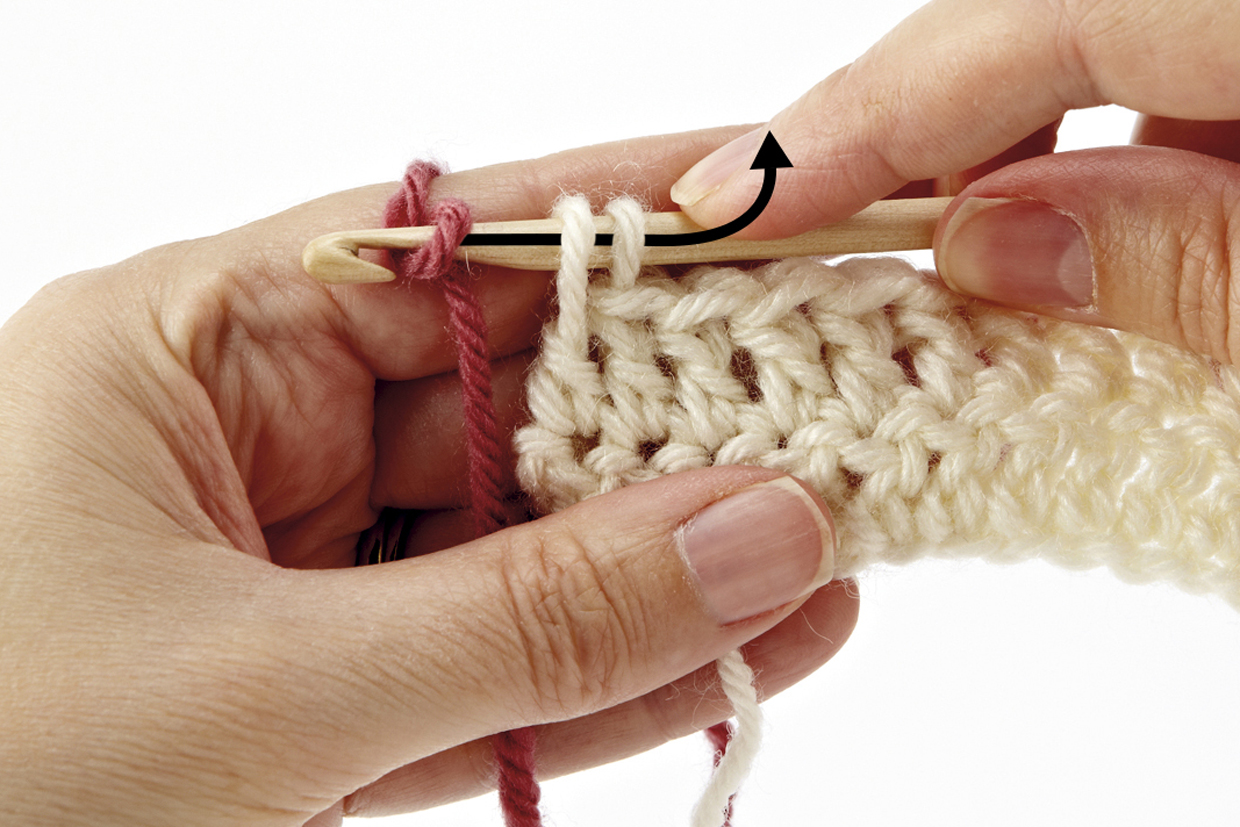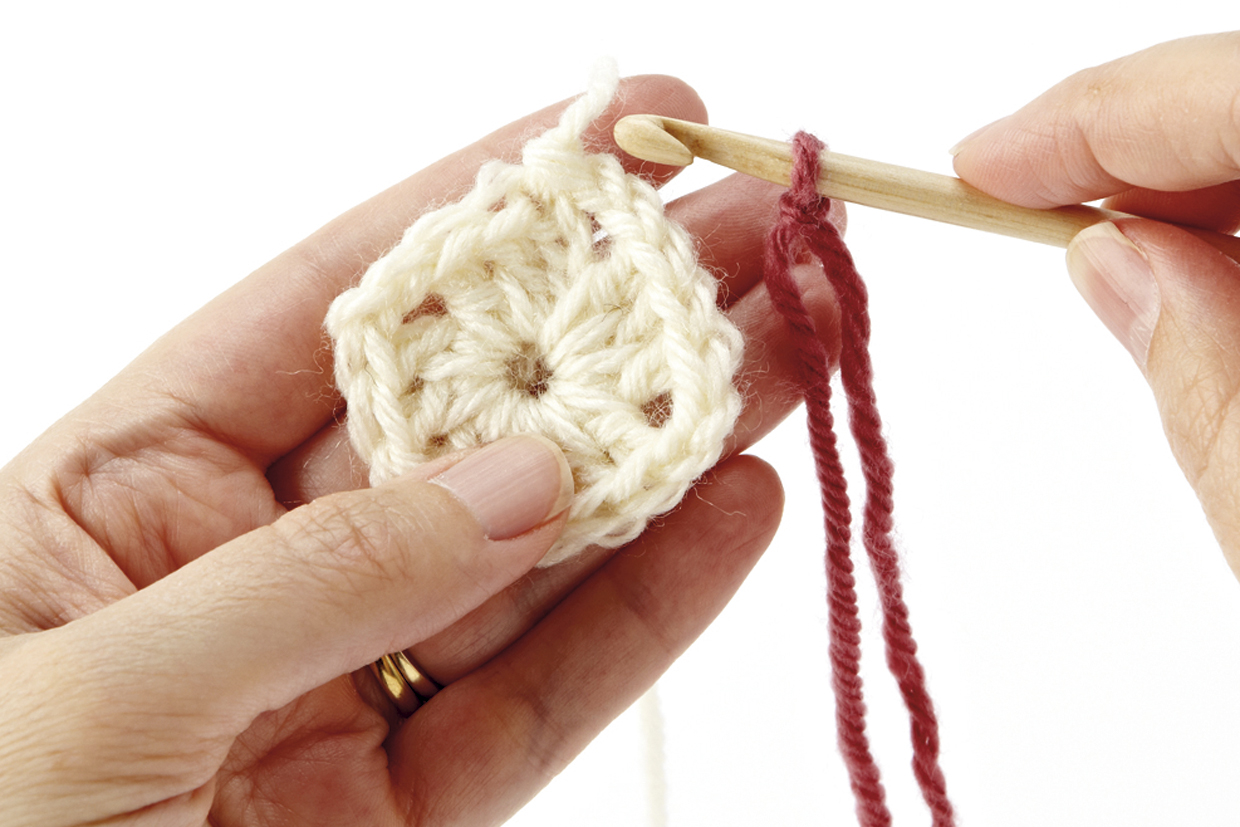How to join yarn in crochet
Step 1
Work on the final stitch before you want the colour change, but stop before working the final yarn round hook (yrh) – for double crochet (below), insert hook, yrh, pull loop through and stop. Cut old yarn leaving a long tail.

Step 2
Loop your new yarn colour around hook (leaving a long tail of the new yarn) and pull it through the remaining loops to finish the stitch. Pull the old and new yarn ends to tighten the loop on the hook.

That’s all there is to it! Once you’ve joined your new yarn it may seem a little loose, but don’t worry too much about this, once you’ve tightened your loop to the hook and made your next stitch with the new yarn it will all be locked into place.
Using this technique will give you a much smoother join that if you were to just tie your two yarns together. Some people still like to tie a knot with the two yarn tails just to make it super-secure, but if you’re doing this it’s wise to do it with the hook in place and before you do your next stitch, as otherwise you can tighten the join too much, making it difficult to work into on the next row.
This is also a handy technique for it you encounter a knot or fault (such as a big fluffy bit) in your yarn ball. Just simply cut out the knot or fault, then rejoin your yarn using the above technique. It’s far better to do this and fix the problem when you encounter it than to just keep on working and have an unsightly bump in your crochet fabric.
How to change colour in crochet - changing colour in crochet rows
Step 1
One of the most popular colour effects you can create with crochet is stripes, so to do this we’ll show you how to change colour in crochet rows. You simply need to use the same sort of colour-changing technique we’ve shown you already above, but on the last stitch of a row, as follows:
Start working the final stitch in the row, but stop before you work the final yarn round hook (yrh). For treble crochet (below), you would work yrh, insert hook, yrh, pull loop through, yrh, pull through first two loops, then stop. Cut the old yarn, leaving a long tail (about 7cm long).

Step 2
Now loop your new yarn colour around the hook, leaving a long tail of yarn (about 7cm long).

Step 3
Pull the new yarn loop through the remaining two loops to finish the stitch. Pull the old and new yarn ends to tighten the loop on the hook.

Step 4
Now you can work the turning chain of the new row in the new colour (3ch for treble). Then work the stitches of the new row in the new yarn colour.

How to change crochet colour in the round - slip stitch method
Step 1
There are many ways to change yarn colour when working in the round. We’ll show you two here, we’ll start with the slip stitch technique, and then we’ll go on to show you the slipknot technique (below). You can then practise these two methods and choose the one you prefer.
The slip stitch technique is good for dense motifs. At the end of the round, work the last stitch as usual. Cut the old yarn, leaving a long tail. Now join the round together with a slip stitch in the new yarn, as follows:
Insert hook into top of turning chain at start of round. Loop the new yarn around the hook, leaving a long tail.

Step 2
Pull through both the turning chain and the loop of old yarn. Now use the new yarn to work the turning-chain and the new round.

How to change crochet colour in the round - slipknot method
Step 1
For lacy motifs and granny squares, it can be easier for you to fasten off each round and join the new yarn colour with the slipknot technique, as follows:
Once you’ve fastened off the previous round, make a slipknot in the new yarn colour and place on your hook.

Step 2
With the slipknot on the hook, insert the hook into the chain space where you want to join the yarn. Hold the working yarn and the tail end at the back of the work (this helps to make sure that your slipknot is not visible from the front).

Step 3
Now work a slip stitch, placing yrh...

Step 4
...and pull the yarn through the chain space and through the slipknot. Tighten the slipknot if necessary. Make the turning chain for the new round, and work the stitches in the new colour for the new round.













